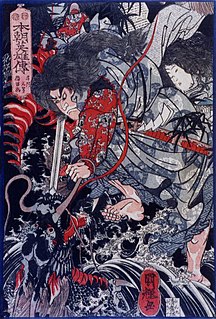 W
WThe Utagawa school (歌川派) was one of the main schools of ukiyo-e, founded by Utagawa Toyoharu. It was the largest ukiyo-e school of its period. The main styles were bijin-ga and uki-e. His pupil, Toyokuni I, took over after Toyoharu's death and led the group to become the most famous and powerful woodblock print school for the remainder of the 19th century.
 W
WUtagawa Hiroshige, born Andō Hiroshige, was a Japanese ukiyo-e artist, considered the last great master of that tradition.
 W
WHiroshige II was a Japanese designer of ukiyo-e art. He inherited the name Hiroshige II following the death in 1858 of his master Hiroshige, whose daughter he married. In 1865 he moved from Edo to Yokohama after dissolving his marriage and began using the name Kisai Risshō. His work so resembles that of his master that scholars have often confused them.
 W
WUtagawa Kunimasu was a designer of ukiyo-e woodblock prints in Osaka who was active during the late Edo period. He was a leading producer of kamigata-e, prints from the Osaka and Kyoto areas. He is also known as Sadamasu [貞升], the artist name he used prior to Kunimasu.
 W
WUtagawa Kunisada, also known as Utagawa Toyokuni III, was the most popular, prolific and commercially successful designer of ukiyo-e woodblock prints in 19th-century Japan. In his own time, his reputation far exceeded that of his contemporaries, Hokusai, Hiroshige and Kuniyoshi.
 W
WUtagawa Kunisada II was a Japanese ukiyo-e print designer, one of three to take the name "Utagawa Kunisada". He headed the Utagawa school.
 W
WUtagawa Kunisada III (歌川国貞) (1848–1920) was an ukiyo-e printmaker of the Utagawa school, specializing in yakusha-e. He began studying under Utagawa Kunisada I at the age of 10, and continued under Kunisada II after their master's death.
 W
WUtagawa Kuniteru was an ukiyo-e artist in the tradition of the Utagawa school. Born in Edo (Tokyo), he studied under both Kunisada and Toyokuni I. He produced prints of a wide variety of subjects, including many depicting the increasing Western influence on Japan, with his main output taking the form of book illustrations and single-sheet ukiyo-e.
 W
WUtagawa Kuniyoshi was one of the last great masters of the Japanese ukiyo-e style of woodblock prints and painting. He was a member of the Utagawa school.
 W
WToyohara Chikanobu , better known to his contemporaries as Yōshū Chikanobu (楊洲周延), was a prolific woodblock artist of Japan's Meiji (era).
 W
WUtagawa Toyoharu was a Japanese artist in the ukiyo-e genre, known as the founder of the Utagawa school and for his uki-e pictures that incorporated Western-style geometrical perspective to create a sense of depth.
 W
WUtagawa Toyohiro , birth name Okajima Tōjiro (1773–1828), was a Japanese ukiyo-e artist and painter. He was a member of the Utagawa school and studied under Utagawa Toyoharu, the school's founder. His works include a number of ukiyo-e landscape series, as well as many depictions of the daily activities in the Yoshiwara entertainment quarter; many of his stylistic features paved the way for Hokusai and Hiroshige, as well as producing an important series of ukiyo-e triptychs in collaboration with Toyokuni, and numerous book and e-hon illustrations, which occupied him in his later years.
 W
WUtagawa Toyokuni, also often referred to as Toyokuni I, to distinguish him from the members of his school who took over his gō (art-name) after he died, was a great master of ukiyo-e, known in particular for his kabuki actor prints. He was the second head of the renowned Utagawa school of Japanese woodblock artists, and was the artist who elevated it to the position of great fame and power it occupied for the rest of the nineteenth century.
 W
WUtagawa Toyokuni II (1777–1835), also known as Toyoshige, was a designer of ukiyo-e Japanese woodblock prints in Edo. He was the pupil, son-in-law and adopted son of Toyokuni I. The former used the name Toyoshige (豊重) until 1826, the year after his teacher's death, when the family gave him the right to use his teacher's name and he began signing his work Toyokuni (豊国). In 1835 he died, and in 1844 the family persuaded Kunisada, the most famous student of Toyokuni I, to use the name "Toyokuni" and become leader of the school. Although Kunisada never recognised Toyoshige's right to the name Toyokuni, nevertheless Kunisada after 1844 is always referred to as Toyokuni III.
 W
WUtagawa Yoshiiku , also known as or Ochiai Yoshiiku , was a Japanese artist of the Utagawa school.
 W
WUtagawa Yoshitaki , who is also known as Ichiyōsai Yoshitaki, was a Japanese designer of ukiyo-e woodblock prints who was active in both Edo (Tokyo) and Osaka. He was also a painter and newspaper illustrator. His father was a paste merchant, and Yoshitaki became a student of Utagawa Yoshiume (1819–1879). Yoshitaki was the most prolific designer of woodblock prints in Osaka from the 1860s to the 1880s, producing more than 1,200 different prints, almost all of kabuki actors.
 W
WUtagawa Yoshitora was a designer of ukiyo-e Japanese woodblock prints and an illustrator of books and newspapers who was active from about 1850 to about 1880. He was born in Edo, but neither his date of birth nor date of death is known. However, he was the oldest pupil of Utagawa Kuniyoshi who excelled in prints of warriors, kabuki actors, beautiful women, and foreigners (Yokohama-e). He may not have seen any of the foreign scenes he depicted.
 W
WUtagawa Yoshitsuya , also known as Kōko Yoshitsuya (甲胡 芳艶) and as Ichieisai Yoshitsuya (一英斎 芳艶), was a Japanese designer of ukiyo-e woodblock prints.